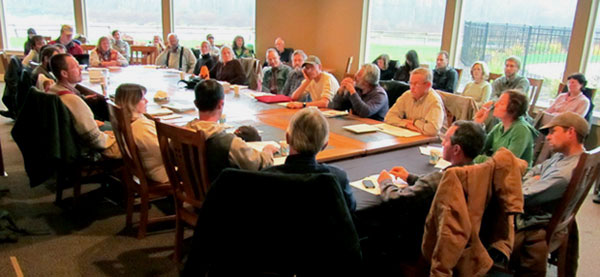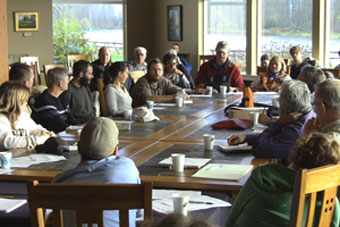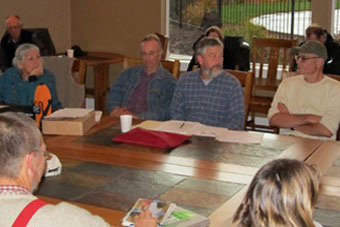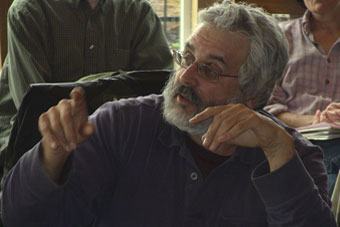

Home | Spaceship Earth | Book Reviews | Buy a Book | Bean and Grain Index | Short Stories | Contact | Mud Blog
By Dan Armstrong
The Southern Willamette Valley Bean and Grain Project hosted its third fall farmers meeting at the River Bend Resort in Harrisburg, Oregon on November 9, 2010. Approximately fifty people, about half of them farmers, were in attendance for a discussion of the 2010 growing season in the south Willamette Valley.
In addition to the farmers and many local food advocates, the group included USDA farm agent Dan Sundseth, Special Assistant to the Director of the Oregon Department of Agriculture, Brent Searle, and the OSU Extension Service horticulturalist Ross Penhallegon. Three bulk food buyers were there also–Greg Wilson from GloryBee Foods, James Henderson from Hummingbird Wholesale, and Mark Beauchamp from Café Yumm.

Farmers who had grown either beans and/or grains in 2010 provided the focus of the meeting. They were seated around seven tables put together in the center of the room for a round table discussion, while the others observed from the periphery. Dan Armstrong of the Bean and Grain Project facilitated the meeting, and Harry MacCormack, owner of Sunbow Farm and the original inspiration for the Bean and Grain Project, opened each round of discussion.
In 2008 and 2009 the fall post-growing season discussions were conducted as two meetings to minimize driving distances. One meeting took place in Eugene, which tended to attract owners of smaller farms, and one took place in Tangent, which tended to include the owners of large grass seed operations. This year it was decided to have a single meeting in Harrisburg–roughly splitting the distance between Eugene and Tangent–for the distinct purpose of increasing communication between the two groups. This did lead to a larger meeting and, as hoped for, also generated one of the project's most elevated exchanges with regard to the cultivation of beans and grains. The larger group, however, only allowed time for three full circuits around the table, so some of the topics on the agenda did not get addressed. More importantly though, the combining of the two meetings brought together a greater mix of people and view points.
It may be that you had to have experienced the meetings during the previous three years to appreciate the difference. The Tangent meetings, convened in the center of grass seed country, have generally had a smaller attendance. Talk has been contained and the mood, to some extent, mirrored the difficulties in the grass seed market. The Eugene meetings have drawn larger numbers and a younger demographic, including mostly, though not entirely, organic farmers working on five acres or less or homestead farmers simply trying to live off their land. This group has been very talkative and was clearly there to share information. Bringing these two groups together for the meeting November 9 did have a positive effect on the overall level and liveliness of the conversation.
At the center of this was the younger farmers' willingness to talk in detail about what they were doing and reveal their personal travails, which were many. This genuine openness was a powerful addition to the larger group as a whole. Civility and honest exchange was the order of the day. This was, perhaps, the most amazing thing about the meeting. Twenty-five people, each carrying his or her own agenda, sat at the table and spoke for two hours with remarkable politeness and courtesy. Little or no facilitation was necessary to keep the discussion moving and not once did someone talk so long they had to be cut off or did someone abruptly interrupt another speaker.


Beans: The meeting began with a brief introduction to the Bean and Grain Project, followed by individual introductions around the table and to the others in attendance. The first topic on the agenda was bean production during the 2010 growing season. Because beans have offered the most challenges to southern Willamette Valley farmers, twice as much time was allotted to this portion of the meeting.
Harry MacCormack opened the round of discussion by stating that a complete report of the 2010 growing season at Sunbow Farm was available on the Mud City Press website. (Link to report.) He then briefly described his experiences growing fava beans, pinto beans, black beans, red chili beans, and garbanzos beans in 2010. Harry did not irrigate these five bean varieties. He used a small, hand-held cultivator to combat weeds and recommended periodic foliar feeding with compost tea. He also grew out eleven test plots of beans provided by Andrew Still and Sarah Kleeger of Open Oak Farm and Adaptive Seeds.
In his production plots, the fava beans and garbanzo beans stood out. The black and pinto beans did well enough considering the weather, but the red chili beans struggled badly in the cool, wet spring. The favas and garbanzos, particularly the Blanca variety, did very well and seemed minimally affected by the weather. Harry planted individual plots of Blancas on March 24, April 23, and May 14. He also planted one plot of Spanish Yellow garbanzo beans, the variety that was grown two years ago at Stalford Seed Farms, on April 23. All of the garbanzo beans, both varieties, were dry in the field by August 23. Though germination rates were lower for the two early plots of Blancas, they way out-performed the May planting of Blancas and the April planting of the Spanish Yellow, generating yields three and four times the others.
Harry spoke highly of the production he got from his fava beans and thought some consideration should be given to favas for commercial production. Of his eleven test plots, he noted that the Yellow Woman and Buckskin beans did well enough to continue testing.
Gian Mercurio of Stalford Seed Farms in Tangent spoke after Harry. She said that they got their beans in late, after the first of June, and though some of the beans grew well enough, none dried in the field prior to the September rain.
Kelly Gordon of Gordon Farms reported growing two and a half acres of orcas, producing 2000 pounds of beans, and one and a half acres of anazasi-type beans, producing about 500 pounds of beans. She also noted that the majority of their beans did not dry in the field and had to be dried in their barn. The planting date was not mentioned.
Andrew Still, Cooper Boydston, and Sarah Kleeger of Open Oak Farm in Sweet Home grew out some sixty varieties of beans in test plots. Their larger production plots of Yellow Woman and Hutterite beans got in late and were not as productive as hoped. Some of this was related to soil quality issues on this first year farm. Andrew suggested that some early irrigation was necessary for the beans. He added that many of their varieties were pole beans and, though productive, would be difficult if not impossible to combine.
Clint Lindsey of A2R Farms outside Corvallis reported growing yellow-eye, pinto, and garbanzo beans. (See Clint's Blog for season long reports on bean progress.) His yellow-eyes and pintos were not successful at all. His garbanzo grew well enough, but Clint felt he needed to plant at a higher seed density. Al the beans were planted in the last week of May. The garbanzos needed to be dried in the barn. Clint also said that A2R Farms is in its first year of transition from grass seed production to organic food crops and that they have some work to do on their soil, which they have already begun to address.
Though beans are capable of growing in secondary soils, in this climate, for good yields, better soil gets better results.
Jeff Broadie and Kasey White of Lonesome Whistle Farm in Eugene did some of the most extensive work with dry-land beans in 2010. They planted eight varieties (Arikara, Calypso, Dutch Bullet, Green Flageolet, Ireland Creek Annie, Jacob's Cattle, Rio Zape, Vermont Cranberry) on May 16 and 17 in plots ranging from a quarter acre to one acre. (See 2010 Lonesome Whistle Farm Crop Report.) They watered six times during the summer with yields in the 800 to 1100 pounds per acre range with a maximum of 1840 pounds per acre for the Rio Zapes. However, the heart and soul of their report, given with real emotion and candor by Kasey, was the difficulty of their harvest. All of their varieties but the Dutch Bullet, which were combined, involved tremendous quantities of hand work, particularly as August turned to September and rain became an issue. The Rio Zape, which grows in a mat of vines, was especially difficult to harvest–and yet it was also the most prolific bean producer. The bulk of their beans did not dry in the field and were dried in their work shed.
Drying time and varieties that lend themselves to combining was a recurring theme throughout this round of discussion.
In terms of acres and scale of production, the Hunton Family Farm, outside Junction City, was the most engaged of the large farms in terms of growing transitional beans–six acres of pintos, five of black turtle beans, five of orcas, fourteen of garbanzos, and sixteen of lentils. Tom Hunton told the group that the orca, black, and pinto did not do well at all, but that the garbanzos and lentils grew well and produced solid yields–particularly the garbanzos which pushed about 1800 pounds per acre. Tom added that foliar tests of his beans showed low nitrogen levels, despite the nitrogen fixing capacity of legumes. He thought it might make sense to grow other legumes over winter in the field prior to spring bean planting as a way to increase nitrogen levels. Tom's garbanzos and lentils were swathed and then were allowed to dry in the field. He was able to harvest with a combine prior to the rain.
Alan Adesse of Hands on Organics manages two small plots, one in Eugene and one in Pleasant Hill. He grew royalty bush beans and fava beans. Alan seconded Harry MacCormack's support of fava beans as a variety that could be worth experimenting with on large pieces of ground.
In summary, the beans remain tempting but problematic. Particularly the leafy beans–pinto, blacks, yellow-eye, and orcas–had trouble in 2010. Though there were some minor successes with each variety, for the most part the cool May and wet June were a struggle for these beans. As in previous years, there was considerably more success with the garbanzos. Harry MacCormack's early planting success with the Blanca variety stands out; however, the weather and wet ground made it difficult for heavy equipment to get in the fields in late April or early May and this meant the larger plots of garbanzos did not get in as early as would be optimal. Tom Hunton's garbanzos (planted May 12) and lentils (planted May 1,7, and 8) were exceptions and provided some hope for multi-acre plantings, much like the garbanzos planted at Stalford Seed Farms in 2008.
Judging from all that was said about beans, getting them in the ground before May 15 seems to be critical if you want them dry in the field by the end of August. If the weather gets cold in May, however, there's no getting around it–it won't make for a good season for the big leaf bean varieties. The small leaf varieties–garbanzos and lentils– can make it through cooler weather. Harry MacCormack's work showed that garbanzos can be planted in early April–and even March.
Along with weed and weather concerns, bean harvesting is still an issue. Finding appropriate varieties that grow well, taste good, dry in a timely fashion, and stand tall enough for clean combining is still a work in progress.
To be realistic, bean production in the Willamette Valley is not for the faint of heart. Success with any of the bean varieties, garbanzos included, is tremendously challenging. Soil quality is a big part of this. Surely beans, with an accent on organic production, are not something that any farmer will master in less than three years of trial and error. For all the difficulties and inconsistencies in bean production, the most positive side of the bean discussion is that there are growers like Harry MacCormack at Sunbow Farm, Jeff Broadie and Kasey White at Lonesome Whistle, and Sarah Kleeger, Andrew Still, and Cooper Boydston at Open Oak, who are experimenting with many varieties, pushing each along for short-season success (less than 90 days from ground to harvest) and acclimation to the region. As time goes on, it seems clear that seed variety and seed acclimatization will be crucial to advancement. That both Lonesome Whistle Farm and Open Oak Farm are growing for product and for seed is a tremendous bonus to all the others hoping to grow beans.
Beans remain a work in progress. There's more to learn.


Grains: The second circuit around the table was directed at 2010 growing season experiences with all varieties of grains. Less time was allotted for this portion of the discussion because the experimentation with grains has not been as extensive or as necessary as for the beans. Wheat and oats have become the grains of focus for the larger-scale growers, particularly organically grown. Both have been grown conventionally in the valley before and the learning curve is not as steep as with the beans. It helps considerably that these grains can be harvested by same the combines used to harvest grass seed and cleaned with the same seed cleaning equipment.
Grains are an easier fit than beans for the Willamette Valley.
Again Harry MacCormack opened the discussion in this round of talk. He spoke mostly of triticale and his experience with the cold weather of early December, which froze out several of his winter wheat plantings. (Link to Sunbow Farm report.)
Andrew Still, Sarah Kleeger, and Cooper Boydston spoke at length about the many varieties of wheat and other grains–millet, rye, amaranth, quinoa–that were grown as test plots at Open Oak Farm. They also grew multi-acre plots of oats, barley, wheat, and buckwheat. Again their results on the larger plots were marginal due to the fact they got on their farm in October of 2009 and wet ground in the spring prevented them from sowing all the acreage they intended. As said before, soil quality was also an issue at this first year farm. Andrew added that they grew several varieties of dry corn at Open Oak as part of their bean and grain CSA. From observations he'd made at Open Oak, he felt that the more nitrogen the wheat got the more susceptible it seemed to be to stripe rust.
Stripe rust was a recurring problem in many stands of wheat in 2010.
Willow Coberly of Stalford Seed Farms reported very successful crops of malting barley, oats, flax, and red and white wheat. Stalford's is the furthest ahead in the grain production, having grown red wheat now for five years. They are also the only one of the larger farms that produced organic grains in 2010.
Clint Lindsey and Mike Richardson of A2R Farms similarly spoke of success with their transitional soft white winter wheat and their transitional hard red. They were the only farm in the valley that had more than 100 acres of hard red wheat. They also grew flax, hulless oats, and cayuse oats for the first time. The flax did not turn out as well as hoped due to a low germination rate and some difficulties combining. Mike seconded Andrew Still's comment about too much nitrogen leading to stripe rust. Clint added that they planted all their wheat in the fall this year, because unpredictable weather could make it hard to get on the ground early enough in the spring of 2011.
Tom Hunton of Hunton Family Farm told yet another success story with his 38 acres of hard red wheat. Tom noted that the protein levels in the wheat seemed to be a function of the nitrogen. When the yield was high, the protein level was low, but when the yield was low, the protein levels were higher. Tom also grew oats. He said his "Streaker" variety of hulless oats was not hulless and that he would sell them for feed.
Alan Adesse of Hands on Organics suggested that foxtail millet could be a viable grain in the valley. James Henderson, the buyer for Hummingbird Wholesale, said he'd spoken to Kevin Murphy at WSU who is looking for people to experiment with growing quinoa. Quinoa has been grown here the last few years in small plots with reasonable success. Harvesting and processing, however, are issues yet to be explored.
Richard White, who grows beans and grains for personal consumption near Portland and who has come to many of the bean and grain meetings, mentioned that Red Fife was the variety of hard red wheat he'd had the most success with.
In summary, of all the grains that have been explored so far, wheat has been the most successful. Soft white wheat has long been grown in this valley. Traditionally it has been sold on the global market, but there is some demand locally. The hard red wheat has a greater local demand, but does not have the same history in the valley. Despite many concerns that red wheat could not be grown in this valley for commercial baking uses, it was grown successfully here in plots larger than thirty acres for the second straight year, and one small grain mill was opened in the south valley in 2010 and a second will be running by the beginning of 2011. The red wheat, however, needs to meet very specific standards for sale to the larger commercial bakeries. The protein level is the first concern, and that seems to be fine, but there are other qualities like moisture content, absorption rate, peak time, and stability that factor into the value and usefulness of the hard red wheat. These are things that local growers are just beginning to reckon with.
Oats are another popular grain that grows easily in this valley. Barley is the same. Neither is as valuable per bushel as wheat, but local and/or organic oats have a local demand. Other grains, buckwheat, millet, rye, quinoa, and teff are similarly being experimented with. Part of the Bean and Grain Project's work is to establish a certain level of diversity in what we grow in the valley; all of these grains could eventually become part of agricultural business models in western Oregon.
One idea that came up during the meeting touched on rotation practices. There is a school of thought that says you may be able to grow wheat in the same field in consecutive years if the soil biology is maintained. Traditionally soil maintenance has been achieved through rotation. This is a long-proven technique; however, it may be possible to use amendments like compost tea to build soil biology, maybe in conjunction with limited tillage practices, to eliminate the need for rotations. This is something we expect to see experimented with in the next few years.
A variety of grains are viable in the south Willamette Valley. Progress with wheat, particularly, has been seen each year. Grain storage is still a major concern that needs to be addressed.
One of the topics on the agenda for the November 9 meeting that did not get discussed was the market demand for locally grown beans and grains. For the third straight year, growers have not met demand so it is clear that the Bean and Grain Project is still growing into its garments. The exact demand for locally grown beans and grains cannot be known at this time, but it is possible to make some rough estimates about the potential size of the market.
A recent economic analysis coming out of the Community Service Center at the University of Oregon revealed some data that might help with this. According to the analysis, the northwest populace consumes 125 pounds of wheat (all products–bread, cereals, pastry, etc) per person per year. If we say that our local market is the Willamette Valley, including the Portland/Vancouver metropolitan area, we are talking about approximately 3,000,000 people–2.2 million in the Portland/Vancouver metropolitan area and another 750,000 residents in the valley. With each person consuming 125 pounds of wheat annually, this means the valley's demand is about 375 million pounds of wheat per year. If we say that this is a fair mix of hard red and soft white, a conservative estimate of 75 bushels of wheat per acre (or 4,500 pounds per acres) means this quantity of wheat could be grown on approximately 85,000 acres.
At this time, more than ninety-nine percent of the wheat consumed locally is imported. Could we gradually, over several years, capture ten percent of this market, we are talking 8,500 acres of wheat for the valley. This is not a tremendous amount, but if we account for crop rotation and the staggering of crops, this will feel like a little bit more. Though this is more than the amount of wheat that could realistically be cultivated by all the farmers at the table on November 9, it is a minor though not insignificant amount of acreage–which could grow beyond ten percent of the market depending on long-term economic dynamics and the price of petroleum.
If we further dissect these numbers and add that the American populace is currently eating four percent organic and that this may be five percent on the west coast, the demand for organic wheat products would be approximately five percent of the total demand or, in terms of acres, 4,250 acres. Considering there is very little organic wheat being grown anywhere and that less than four hundred acres of transitional or organic wheat was grown this year in the Willamette Valley, we have barely scratched the surface of the local organic wheat demand.
More generally, wheat offers the advantage that whatever is grown that can not be sold at premium prices for being local and/or organic can be sold regionally or even globally. In the model envisioned by the Bean and Grain Project, farmers should sell first locally, which would be at a premium, then regionally, and once that demand is met, globally. The global market for organic wheat is modest yet on the up swing, but regional demand for organic wheat–California, Oregon, and Washington–is considerable and growing, meaning saturation of the organic wheat market is still a number of years off.
If we apply the same logic to beans, according to the recent economic analysis coming out of the University of Oregon, each northwest resident eats 13.5 pounds of beans a year. Multiplying that by the three million people that live in Portland and the valley, the bean demand each year is about 40 million pounds. If we can grow 1500 pounds of beans per acre, this comes to approximately 27,000 acres of beans–all varieties. If ten percent of that figure represents an optimistic demand expectation for locally grown beans, then we are looking at 2,700 acres of beans–half of which would be for organic bean demand.
Again demand could go beyond ten percent of the market, and organic demand is likely to increase, but from this point in time, ten percent looks like a steep hill of beans to yet climb. In any case, 2,700 acres is not a tremendous amount, but if it is understood that beans, especially local and organic, are a crop that can offer a premium return, this acreage can not be dismissed as nothing. Add that the beans are not easy to grow and that experience and practice and trial and error and seed acclimatization are required, it must be understood that we are talking about a specialty crop that still involves quite a bit of work.
However, much like the wheat, there is demand in our region and other parts of the United States for dry beans, particularly organic beans. Meaning once the local demand is met, there are options for regional sales but not at premium prices. As recently reported in the Capital Press, there is a glut of conventional dry beans this year and prices are down; however, organic beans are still held dear. All things considered, we are even further from meeting the demand for beans than we are for wheat.
(It is worth noting that dry beans are grown in eastern Oregon. The Vibbert Ranch in Madras already account for several hundred acres of pinto beans. There are also several bean farmers in Malheur County. If you look at the regional bean processors in Eastern Washington (Kelly Bean, Davidson Commodities, Hinrich's), they contract for several million pounds per year.)
If we address all the various grains–wheat, oats, rye, barley, and perhaps others–and the wide variety of beans, there are real opportunities, especially when on-farm processing and bagging is included. The demand is not so great that it will change the face of farming in western Oregon, but grains, particularly, and beans can become viable parts of large grass seed operations or small organic farm models.
Summary: After three years of Bean and Grain Project meetings, the farmers are gradually getting to know each other and there is a good bit of friendly socializing that goes on before and after the gatherings. This should be underlined because the Bean and Grain Project farmers meetings, the meeting November 9th included, are only intended to open the discussion. Not every farmer is comfortable talking in public about their business model or farming practices. This is well understood and widely accepted. But these meetings and discussions, limited as they are by time and circumstance, are not meant to stop when the meeting ends. The hope is that there will be deeper, more in depth discussions to follow in the breakfast joints and seed stores and coffee shops where south valley farmers might collect and talk. "What da'think about growing beans? Are those folks nuts or do ya think it could work?" This is what the meetings hope to prompt.
This said, it should be emphasized that times are not usual. The valley is amid a very difficult period. Just like the economy as a whole, the grass seed market is still in a funk and a damn question mark regarding next year and the year after that for who knows how long. With the mortgage and foreclosure mess that is currently gripping the nation, a boom in housing starts is not just around the corner. Speculation on this may be a fruitless endeavor, but regardless of what happens in the near or long term, it seems evident that there will be a transition to a larger variety of field crops and a more diversified business model for all the large farms. This will take several years and will be hard enough if people work together, but almost impossible if not. That's one of the points the Bean and Grain Project seeks to emphasize. The times have changed in some fundamental way regarding the economy. The price of petroleum products and farm inputs are part of it. Food crops are going to have a far more meaningful and sustainable value than lawns for what could be a long time to come. The sharing of knowledge, the sense of cooperation, even the cooperative ownership of machinery and processing facilities–and this is already happening–will be necessary in the retrofitting of an agricultural system aimed almost solely at grass seed production to one that incorporates several more food crops into the model. If nothing else, the courtesy witnessed at the table during the November meeting and the upbeat mood of the group speak optimistically to further cooperation.
As always, feedback to this webpage is welcome. If you attended the meeting, feel free to offer corrections or additions. In the end, the Bean and Grain Project meetings, farm tours, and these articles are meant as a forum about growing beans, grains, and edible seeds as field crops in the Willamette Valley. Discussion and the sharing of ideas are themes central to the project. Click to email.
_______________
Special Thanks: The Bean and Grain Project's two supporting non-profits the Willamette Farm and Food Coalition and the Ten Rivers Food Web were instrumental in the setting up and organization of the Harrisburg meeting. Thanks to both of these non-profit organizations. Also much thanks to Oregon Tilth; they paid for the rental of the meeting space. And thanks to Hummingbird Wholesale and the Evergreen Hill Fund of Oregon Community Foundation for their continued support of the Southern Willamette Valley Bean and Grain Project. Photos courtesy of project videographer Erik Silverberg.